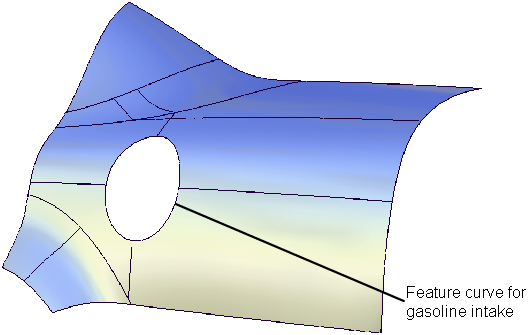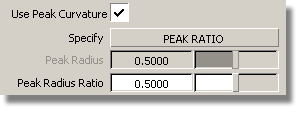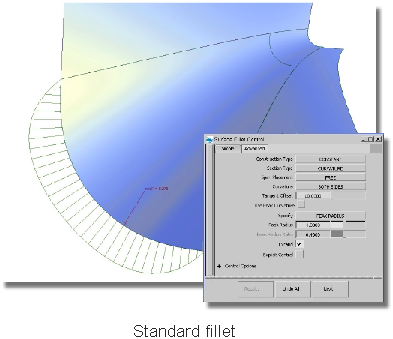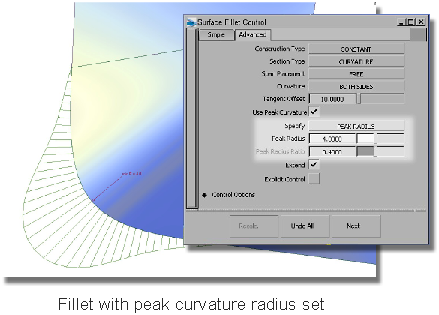The tool provides you with an automatic functionality to create a finish on the edges of a surface model. By using one or more
of the following: edge, curve-on-surface, boundary edge, or iso-parametric line, the tool creates a tube that touches the
selected geometry. The tool also creates a linear extension — a flange — on the tube. This extension can be defined by a sweep
angle or a vector plus a draft angle.
Tube Flange Control
Tube
-
-
Choose either or continuous to the base surfaces.
If is selected, options can be set:
The peak radius parameter is only visible if the fillet/tube radius/tangent offset is not variable. If is visible you can
specify either a radius or a ratio.
The ratio is the ratio of the radius/tangent offset to the peak radius, and can be used for either variable or fixed radius
fillet.
The following illustration shows the difference peak curvature can make to a fillet.
-
-
Defines the radius of the tube. This option is grayed out if is set to Radius and more than one manipulator is used. You must define the radius interactively on the model by dragging
the manipulator in that case.
-
-
Enables you to put the tube on top of or underneath the surfaces.
Flange
-
-
Set to either or . defines where along the tube the flange will be tangent to the tube. uses a vector and draft angle that determines the direction of the flange. If you select , you must pick a vector, or specify it through the .
- or
-
Provides a slider to control the angle. The default is 90 degrees for Sweep, and 0 for Draft angle. Either angle can be variable.
-
-
Enables you to flip the direction of the flange. This option is grayed out if at least one of the input curves is an edge,
and thus, there’s only one valid orientation of the flange.
-
-
Determines whether or not a flange will be built off the edge of the tube. To create a full tube, use a of 360 degrees. Note that the tube will be trimmed according to the or settings, even if is off.
-
-
Determines the length of the flange that will be built, if is on. Length can be variable.
Parting Line Vector Options
These options only apply when is set to .
-
-
Select one of these to specify a pull direction along that axis.
-
-
Select this option to specify a pull direction normal to the current view. The vector is not drawn in the view windows.
If the current view is changed, click to update the vector.
-
-
Selecting this option lets you specify the name of an existing vector in the field, or pick the vector in the view. This vector defines the pull direction.
-
-
This button only appears if is selected. Click it to update the vector if the view has been modified.
-
-
Click this button to create a vector construction object in the view windows. Unless you do this, the vector direction you
specified is used by the tool, but you will not see and be able to re-use the vector.
Surface Structure
-
-
If you choose , a single tube surface is built. If you choose , the tube is split at curve boundaries, which also include surface boundaries, since a curve cannot span more than one surface.
-
-
This option only appears if is set to . If it is checked on, each surface will be a Bézier patch.
Bézier patches have a single span, and their maximum degree in the U direction is set through the section. The default is degree 5.
-
-
Gives you controls of the surface degree and maximum number of spans in the tube and flange surfaces.
-
-
The degree of the tube and flange surfaces in the U direction (that is, along their length). Enter a whole number from 2 to
9. This option is only available when is checked.
-
-
The maximum number of spans in the entire tube and flange surfaces if is set to , or per surface if is set to . This option is only available when is checked and is unchecked.
-
-
In the case of cross-knot insertion, the system will not allow spans of a linear distance less than the Short Edge Tolerance.
Control Options
Note that only one of the three parameters can be variable. For example, it is not possible to create a variable radius tube
with a variable length flange.
-
-
Gives you the ability to interactively modify the , , or
-
-
If this box is checked, selecting a surface curve also selects all other surface curves that are tangent continuous with it.
-
-
Choose whether to get visual feedback about continuity (set in the Tube section). Green indicates success; yellow indicates
that the continuity condition has not been met.
-
-
Choose between updating changes by selecting the button, or automatically updating changes.
Tip
If is set off, use the spacebar to press the button.
Variable controls for this tool are provided in the modeling window.
Controlling the variable parameter in Tube Flange
The variable parameter (radius, flange angle, or flange length — as specified by in the control window) is controlled using a set of manipulators in the modeling window. Only one of the parameters can be
varied: the other two are held constant.
Each manipulator consists of two handles — the rail slider and the value handle — only one of which can be active at a given
time. The active handle is shown in light blue. The rail slider, a "ball" sliding along the rail, indicates the position on
the rail where the value applies. The value handle, an approximate cross section of the future surface, controls the value
of the parameter at this point.
The value of the active handle is shown on the prompt line.
For all of the following operations, use the  , unless stated otherwise.
, unless stated otherwise.
To activate a handle, click it.
To de-activate the currently active handle and switch back to the picking mode, click anywhere on the screen (without dragging
the mouse).
To add a new manipulator, click the desired point on the rail.
To move a manipulator, drag the slider using the  . Alternatively, activate the slider and type in the position (in the range from 0 to 1) along the rail.
. Alternatively, activate the slider and type in the position (in the range from 0 to 1) along the rail.
To adjust the parameter value, click and drag the value handle. Once the handle is active, the mouse can be dragged anywhere
on the screen. Alternatively, activate the handle and type in the value in current units.
To delete a manipulator, Shift-right click it.
If a single manipulator is used, the parameter is constant, and its value can also be adjusted in the control box. As soon
as another manipulator is added, the value in the control box is grayed out.







 , unless stated otherwise.
, unless stated otherwise.
 . Alternatively, activate the slider and type in the position (in the range from 0 to 1) along the rail.
. Alternatively, activate the slider and type in the position (in the range from 0 to 1) along the rail.